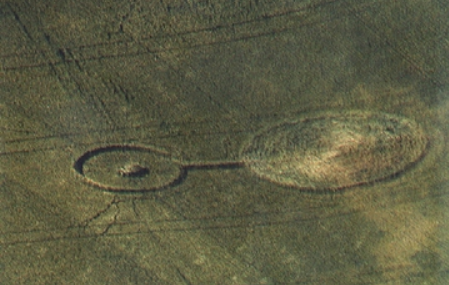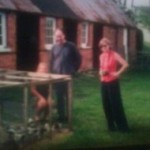MORE SYNCHRONICITIES –
NORTH DAKOTA, 2000
NOTE: All three circle diagrams can be found at Paul Vigay’s archives by year and location: 2000, North Dakota. (Paul was a shining star – he will remain a shining star – Stace, 22 February 2009.)

My first trip to visit US crop circles after Inman in 1995 and travelling to England in 1997 took me from Denver to just shy of the Canadian border in North Dakota and back – in one weekend.
That expedition in late summer of 2000 brought more transformative synchronicities, adding to the ones I described in my prior post Pleiadean Communication and Crop Circles.
How deeply these synchronicities affect me and my world is hard to describe – although I’ll try my best.
The trip from Denver to Langdon and back took all of about 57 hours – about 35 of which was spent driving. We put almost 2500 miles on the car. I got only a few hours sleep total over those three nights: none on Friday night, perhaps three hours on Saturday night, and an hour or two on Monday morning before work.
Wow. What a drive. Good thing my friend Lyn was with me to help out – and it was her first visit to a crop circle!
Back to synchronicity…..
The first synchronicity was when I realised that there was a new crop circle in the US in Langdon, North Dakota. Yes, it was far, far away – but 16 years earlier I had graduated high school at a very small school at Langdon, Kansas. So my ears perked up.
Langdon is not a common place name, as I found out while searching through the atlas during the 17 hour drive to Langdon. Between the lines I could make out a message from the circle makers, “Now you’ve got your education, so put it to use!”
Turns out that Langdon, North Dakota, at -98.368W longitude, is almost precisely north of Langdon, Kansas, which sits at -98.325W longitude. I tried to figure out how far off an exact longitude line that would place each small town, and so far I haven’t come up with a conclusive figure – though it can’t be more than a handful of miles.
So we arrive in Langdon around 3 PM local time Saturday, and I call farmer Ullyott again (I’d of course called him they day before, to get permission to go into his field.) He met up with us several miles north of Langdon and we walked out into the crop circle, which couldn’t be seen from the road, being a few hundred yards out into the wheat at the top of a small rise in the otherwise flat landscape.
Although I hadn’t slept for over 30 hours, my energy was stoked as we made our way through the long-awaited, familiar sound of wind-brushed, ripening wheat, which swayed like hula skirts around our legs.
Most of the wheat was laid flat to the ground in this dumbbell-shaped formation – similar in many ways to the Inman circle, the “Tractor” (again, referenced in “Pleiadean Communication…”) – but hundreds of standing stalks caught my attention upon first entering the formation.
In many crop circles, both human made and non-human made, the downed wheat will stand back up fairly quickly due to the plant’s innate desire for sunlight, growth, and photosynthesis. In this case, the standing stalks were more numerous than in other circles I’d seen, but seemingly randomly placed within the formation.
Examining them carefully at the base I could see that these stalks appeared to have never been flattened; somehow, they were simply left standing.
The largest circle in this formation was where I found a good-sized chunk of granite – pink, black, and white – sitting on top of the dirt in the exact center of downed wheat. The stone dowsed very, very strongly for many months. Over the years the energy has gradually attenuated, mellowing like brown on wood, the dowsing rods reacting differently today than then.
The Bata circle, a few miles south and west of Langdon, was our second stop. This second one resembled, to some, a flowerpot (which I never quite understood); to others, it was a microscope. In this formation Lyn and I were sitting in the center of a radially-splayed circle and found a huge ladybug crawling up my arm. Its right wing was distorted. On closer look it appeared that the wing itself had been singed, shrunken and curled around the edges – yet the ladybug was full of life. She was definitely something to behold.
After the unslept rush of immersion in the crop circle energy, I remember the frenzy of mosquitoes buzzing the field just after the sun slipped past the horizon. We were exhausted, yet incredibly energised at the same time. By nightfall we’d visited and documented two powerful, yet very different, crop circles.
By the time we’d done as much as possible with the second crop circle, night was falling and as mosquito-laden as we could bear. We decided to go to dinner, chat with some folks about our work, and try to get a few hours sleep.
We had to leave for Denver before sunrise, so the third Langdon circle was out of reach. But..that night we heard rumours that a new crop circle had also been spotted at Thompson, just south of Grand Forks – which we would drive past on our way home the next morning. So despite the 17 hour drive we faced the next day, we decided to take a slight detour to the small town of Thompson to look for the rumoured fourth crop circle.
It was just after sunrise on Sunday morning when we arrived at Grand Forks, within elevator-sighting distance of Thompson, and I don’t recall seeing any cars on the road on the way to the newspaper office. They hadn’t answered their phone earlier. And then nobody was there when we arrived and knocked on the door and phoned again, so we went on to Thompson without a location or anyone to contact.
Thompson’s a small town with a 3- or 4- barrel grain elevator. It’s a very sleepy Sunday morning town.
Lyn and I drove for miles looking for the crop circle, but we knew we were talking a good hundred or more square miles land unseen by air. Each glance into the flat fields was roulette. Then finally something yawned awake in the northern prairie: the sun came out suddenly and filled everything with “wakey wakey!” And finally we had a few people trickling into town to talk to, to find out at last where the crop circle was…
….but no one had heard of it.
After asking everyone we could if they knew of it, or if they knew what a crop circle was, and getting only dumbfounded gestures in response, Lyn had started the car, turned up the music, and had the A/C on full blast. I had one foot in the car, disappointed and deflated after the anticipation of getting into one more circle before heading back to Denver.
Remember, by now it must’ve been around 8 o’clock and we still had a good 15 hours of driving to go to get home.
“Just a minute. Just one more…”
I walked over to the fellow putting gas in his old pickup. This guy had long hair pulled back in a ponytail, wore a plaid shirt and cowboy boots, and wasn’t looking up for anything. A dog, a border collie mix perhaps, peeked out the back window from the cab, practically wagging the truck.
“Hello there – my friend and I have come from Denver to investigate crop circles in Langdon, up north, and we’re heading home now – and we’ve got a really long drive ahead of us today – but we heard there was a crop circle at Thompson and we’ve got to find it if at all possible. Have you heard of it?”
He continued pumping gas, ver-r-r-r-ry slowly lifting his head so that his eyes were almost level with mine. “It’s in a field across from my house.”
I had hit pay dirt! WOW! Even though the field had already been harvested, I knew that the crop circle would still be there to experience, because flattened crop circles aren’t destroyed by combines.*
We followed Scott and his dog seven or eight miles in a slather of dust and chaff out west and south of town and right into a field. Stubbled wheatstems polished the underside of the rental car as we drove a couple hundred yards to the circle that lay undisturbed on the ground, shining in the sun.
Thus begins the story of one fabulous crop circle near Thompson, ND, during the late summer of 2000.
A “Circle in Parentheses,” I call it.

Thompson, ND (copyright Stace Tussel)
The farmer, John Adams, had been harvesting the field a few days earlier when he came across the circle, which had apparently been undetected until then. He felt a strange energy emanating from the pattern, and so did his wife Bonnie when he brought her back to see it before continuing the harvest.
Bonnie was having a hard time believing it wasn’t otherworldly. Her film came back with the photos just snapshots of yellow. (My film was unproductive too.)
Years later, the shape and diagram of this crop circle resonates as strong as the day I walked into it.
I receive a message from this crop circle, gazing into the black cut-out of the “circle in parentheses.” The synchronicities are so intricate and interwoven beyond what’s already described – and I can’t go into that here in this short post. Perhaps some other time.
I believe one use of parentheses is to highlight: 1) “A qualifying or amplifying word, phrase, or sentence inserted within written matter in such a way as to be independent of the surrounding grammatical structure.”
So the Thompson formation can be a message from the circlemakers that the true circles are always composed of circles. Also,
2) “A comment departing from the theme of discourse; a digression.”
There are various themes departing from the original phenomenon, but I figure that a central feature of the real circles is that circular geometry is *the* radical component of any true formation…
STACE TUSSEL
* Note: A year and some months later, I was again in North Dakota to film a TLC documentary: “Crop Circles: In Search of a Sign.” We hadn’t included the Bata formation during filming, so I had a little time to myself that afternoon. I found the little hill where the crop circle had lain, and held my dowsing rods out as I walked up to where I remember the circle had been. It was tilled dirt with no sign of seedlings or anything green. The sky was overcast. And it was very cold, and windy – yet the dowsing was immensely strong – in fact there’d been very little attenuation at all. Despite the blustery conditions, the rods clearly followed the intricate lay of the crop circle that had been plowed under many months before.
* Interestingly, the decomposition of the plants means that the wheat seeds from crop circles are naturally incorporated into the soil to germinate alongside the next planting. More about that consideration in my article, with graphic, about the Herington, KS crop circle of 2006.


